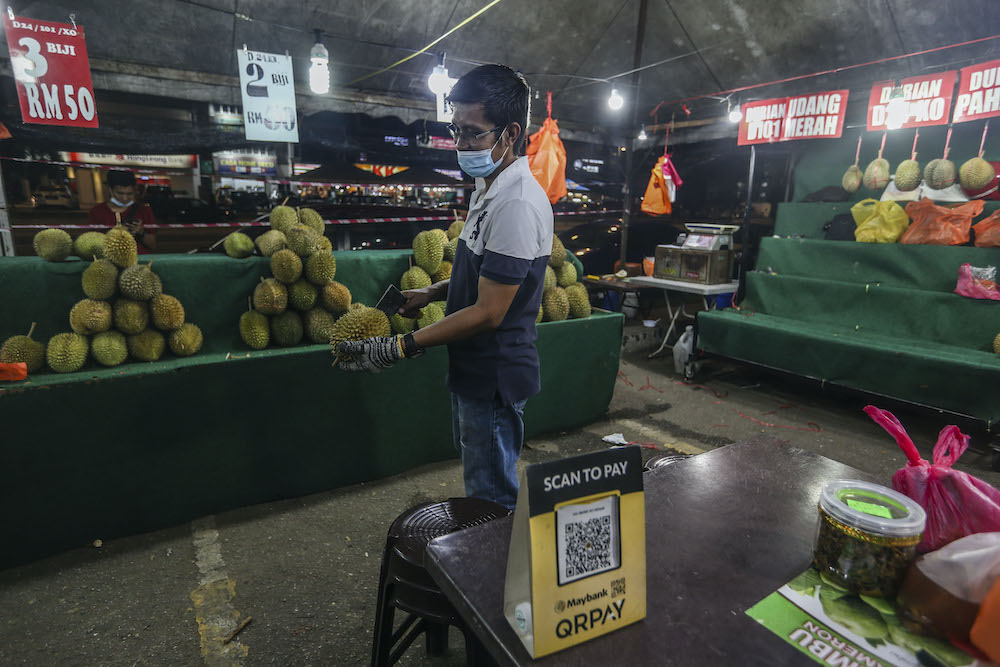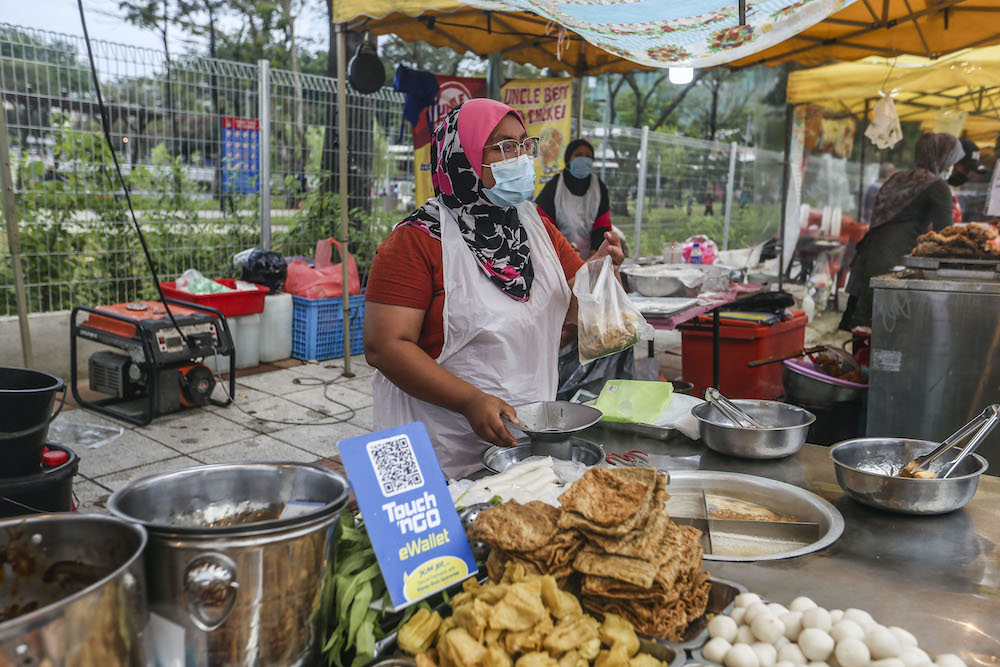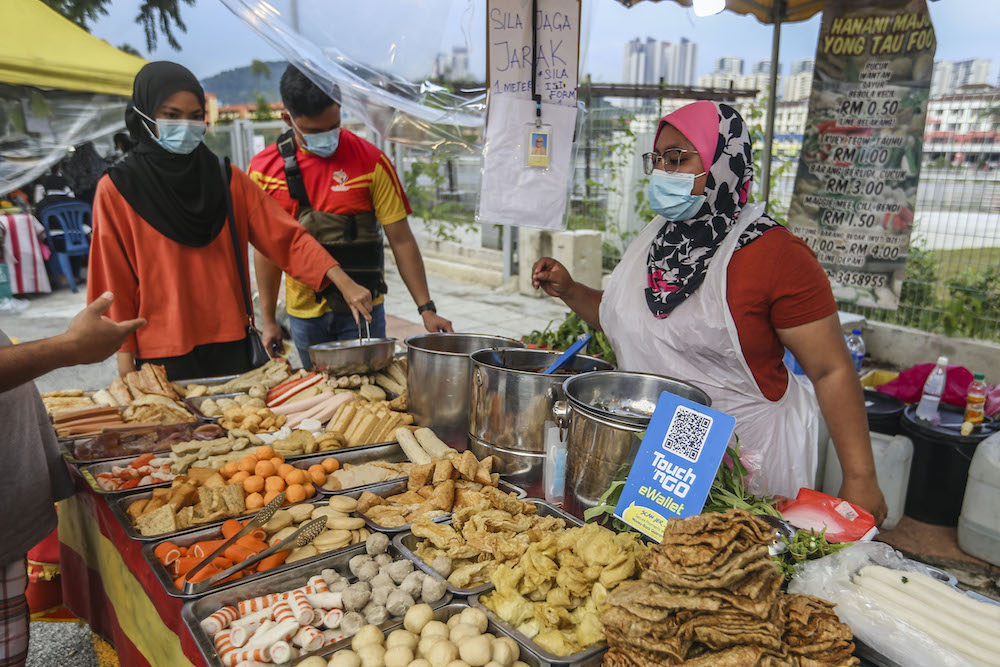KUALA LUMPUR, Aug 22 — Before Covid-19 hit Malaysia, Chan Ming Kit never imagined he would be buying a drink from a roadside stall without cash in hand.
Today, he is happy that he can use his Touch n’ Go e-wallet for even one packet of sugarcane drink at the pasar malam.
“If there is an option of cashless payment, I’d opt for that. It’s really convenient especially when you go to the night market, and will have a lot of shopping to carry, you don’t have to fiddle with your wallet.
“It’s just the safer option now with Covid-19 still lurking around. The best part of cashless payment is, if you forget to withdraw money, you can still go shopping,” he told Malay Mail.
Since the coronavirus pandemic, many small business owners in the country had to think on their feet on how best to ride out the pandemic without going bust.
This included switching business models and adapting to contactless payment and delivery systems when the country went into lockdown mode for almost three months from March to May.
During the initial stages, many thought it would be troublesome to adapt, but today many are glad they are on digital platforms when others have been forced to shut.
Yap Choon Check, 67, owner of Ah Seng Hainanese Chicken Rice in SS2, Petaling Jaya said it was an inevitable choice that he had to make if he wanted his business to survive.
“We decided to use the cashless system because it is the safest option to prevent the virus from spreading and you just have to keep up with the times.
“Moreover youngsters prefer to use mobile applications. It’s the in-thing for them now, so this appeals to them too,” he told Malay Mail when met at his stall in the popular food court better known in Cantonese as Wai Sek Kai, meaning Glutton Street.
Many of Yap’s neighbours in the food court could be seen displaying signs for QR codes and cashless payment options like the stalls selling fried kuey teow, chee cheong fun or flat rice roll, wonton noodles and rojak.
When Covid-19 hit, Yap said hawkers at the food court started to move onto digital platforms, including enabling delivery services because people were afraid to come out, even for a meal.
“But for me, I see it as a way forward for the food sector, because both cashless and delivery services are convenient. I hope these technology conveniences are here to stay, it really helps us through this down times,” he said.
Yap added that the platforms available for cashless transactions are very convenient and hassle-free.
“So far we have been getting payment on time. It’s really easy to apply for a QR code,” he said.
Blessing in disguise
While the pandemic has been a challenge, it has also proven to be a catalyst for the adoption of tech by small businesses.
SS2 Durian House was among the early embracers of cashless payments in the area since two years ago and glad to have done so ahead of the current digital wave. Cashless platforms like Touch ’n Go, Fav Pay, AliPay, Boost, Union Pay and credit card payment were displayed prominently when Malay Mail visited.
The owner who asked only to be named Lim called it a blessing in disguise, saying doing business in the Covid-19 era is all about contactless transactions.
“You can’t refuse to use it, because of safety and hygiene, two things that Covid-19 emphasises. But we also respect customer preferences, some still prefer to pay with cash,” he said.
Lim added that since the pandemic hit the country, he has started delivering durians to customers at home, even though he wishes he could avoid doing so.
“Of course if you ask me we would prefer not to deliver, because we still need to pay a fee to the service provider. But if we don’t, we might end up losing out business on the delivery platforms.
“This is to cater for people who are still afraid to come out and dine in at eateries,” he said.
How easy was it for small traders to get QR codes?
Penang-based Oh Chin Eng said cashless payments are practically the norm on the island now.
The 32-year-old who just started up a specialty coffee kiosk called Nui said contactless payments enabled him to cater quickly to more customers and was safer as he did not have to carry cash in hand.
“In Penang, hawkers have adapted well to digitalisation. This is even noticeable in night markets.
“Hawkers actually prefer cashless while consumers prefer no physical touch,” he told Malay Mail when contacted.
The entrepreneur said getting a Maybank QR code for his start-up was very simple and can be done in just a few minutes.
“The QR code is generated from your personal Maybank2u mobile application.
“The Maybank account is just your personal bank account. From the mobile application, just click QRPay then the QR code will appear where customers just need to scan it,” he said.
As for merchants, they can opt to use the customer self service using Static QR Code, a code generated from the merchant’s bank account (either printed, or generated from their smartphone) and the customer can enter the amount to pay. These are the two kinds of QR code options available with Maybank.
Apart from eateries, the transaction digitisation is also used at morning markets and night markets.
A trader at a Setapak morning market on Jalan Rejang in KL said the cashless payment system is fast and most importantly reduces human contact ― one of the ways Covid-19 could be transmitted.
“I remember during the initial stages of the movement control order, people who came to the market and used cash, to prevent themselves from touching the cash notes, they wore gloves and had a separate plastic bag to store their money.
“Some told me that they even wash their money before keeping it in their wallet. But with cashless payment, we don’t have to worry about all that anymore,” said the market trader who only wanted to be known as Kim.
She said many of her customers now opt for delivery service too instead of visiting the market for their shopping.
“It wasn’t easy for us to adapt, especially with groceries, people prefer to pick and choose. But our regular customers, they trust us to pick out their groceries, so now I even get grocery lists on WhatsApp and they just need to wire money to me and the purchase is done,” she said.
Kim said her regulars can opt to get their groceries delivered through a third-party, or she will drop off their orders personally after she closes her market shop for the day.
“Actually if you ask me, we used to do this a lot back in the day. So we’re just going back but modifying the method with WhatsApp and payment done online,” she added.
Cashless platforms were introduced in January by the then Pakatan Harapan government to promote greater efficiency and transparency in businesses and to prevent corruption.
It kickstarted the initiative with a complementary RM30 e-wallet spending money for all Malaysians, encouraging them to register their very own e-wallet account.
Prior to that, small businesses like hawkers and market traders were reluctant to adopt cashless payment systems, fearing that there were additional fees needed to be paid to obtain payment platforms.
Nowadays, more and more are jumping on the bandwagon. Yesterday, the Health Ministry announced that the cashless electronic payment methods for healthcare services will now be available at 139 hospitals, 144 health clinics and four health institutes nationwide.





















